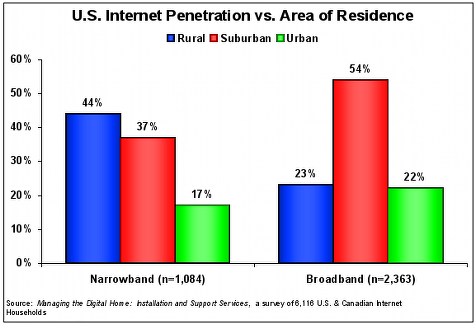
The use of power lines as a medium for communication services has been widely discussed for many years. Similar to the characteristics that led to the development of DSL (digital subscriber line), the use of surplus frequency space on power lines for communication is a simple concept that has been difficult to implement.
However, as the broadband gap between rural and more densely populated areas in the United States continues to widen, the idea of sending signals over power lines is gaining ground as a viable broadband option. Utility companies’ interest in BPL (broadband over power lines) has increased as well because this technology provides a possible tool for improving overall power management.
The Rural Divide
While broadband services have penetrated a large portion of the United States, many rural communities still have few options beyond dial-up. Parks Associates’ “Managing the Digital Home: Installation and Support Services” showed that 44 percent of dial-up subscribers live in rural areas. Furthermore, only 23 percent of rural residents subscribe to broadband services.

Parks Associates research also shows that this low broadband penetration is not due to lack of demand. Twenty-four percent of rural residents using dial-up are very interested in upgrading to broadband services, a number similar to the percentage of high intenders in suburban and urban areas (27 percent and 22 percent, respectively).
These findings show an opportunity is available for alternative broadband providers that can balance the capital expenditures and the revenue structure associated with serving these populations.
Utility Company Perspective
For BPL to become a legitimate broadband option in the United States, the utility companies must be involved. The use of their infrastructure is the key to making BPL a profitable enterprise.
Past failures in providing new services and an overall industry tendency to be slow in adopting new technology have limited their adoption of BPL in the United States. However, utility companies are beginning to understand the benefits that BPL can provide not only to their own power networks but also to their customers.
For utilities, the most attractive feature of BPL is the use of “smart grid” services. As energy prices continue to rise, the utility industry is being pressured to manage its grid more efficiently in terms of cost and power demand.
Because of BPL’s duplex communication functions, it can provide the metrics needed to reduce costs by automating many tasks that are currently being performed manually.
Some of these duties include outage detection, automated meter reading, remote monitoring, and voltage monitoring throughout the system and security functions. These types of measurement solutions will ultimately persuade utility companies to use BPL equipment and services.
Factors for BPL Success
Most telcos and cable companies have chosen not to expand their networks to rural areas because of the high installation costs and reduced revenue potential.
Some BPL vendors are filling this void and beginning to find success by minimizing installation and operating costs while providing a high level of service comparable to that offered by existing broadband options.
To ensure future success, BPL vendors and service providers will need to do the following:
- Minimize capital and operating expenditures by developing solutions that can transmit broadband signals over long distances with minimal line degradation and injection points.
Most of the typical expenditures associated with installing broadband service are eliminated when using existing utility lines. However, BPL providers incur costs each time equipment is installed to boost and/or transmit the signal down the line.
The successful companies in this space have continually improved equipment such as couplers and regenerators that can pass on signals over long distances, thus lessening the interaction with line equipment.
Other vendors have developed solutions that bypass the medium-voltage lines altogether and send broadband signals wirelessly from the central office directly to the low-voltage lines and into the home. These solutions result in even lower maintenance costs and less grid disruption than the medium-voltage solutions.
- Offer a suite of products and services that provide utility companies with “smart grid” metrics.
For BPL to become successful, utility companies must see benefits outside the stream of revenue generated from the delivery of broadband communications to their consumers. “Smart grid” services can provide the added incentive for utility companies to embrace the integration of BPL on their networks.
- Develop partnerships with service providers and utility companies to deliver broadband services to consumers.
Most power companies do not have the experience or the capital funds to pursue a business model in which they provide both the back-end and the front-end broadband services to their customers. By outsourcing the retail broadband services like marketing and customer service to other firms, utility companies will still capture a portion of the broadband revenue without having to incur the financial and administrative burdens associated with retail service.
Chris Roden is a research analyst at Parks Associates.












































Hello,
Not quite sure how this will be profitable to power companies… rural users can increase their speed to 768k as opposed to 56k with regular dialup just by subcribing to satellite internet services, usually affordable alongside digital tv subscriptions. So-called power company broadband isnt much faster (if at all) than 768k downlink anyways. Just research this info on google and find out for yourself. Satellite companies can sign up anyone anywhere. No offense, but id like to see power companies stream television through the power lines lol.
Also.. there are additional concerns with licenced HAM (shortwave radio users)radio operators, and how the implementation of additional frequencies over power lines can interfere with atmoshperic sw radio signals. This is bad and heres why…
Brad Coursey states on ZDnet:
WHY SHOULD YOU CARE about all this? Because BPL could have a negative impact on the entire world of radio communication. Remember what I said earlier about the radio waves flying off into space? Even the low-power signals BPL would employ can, under the right conditions, travel around the globe. That means BPL systems in the United States could cause interference in places far removed from whatever benefit BPL is supposed to provide.
Interference is pollution and, once it starts, can prove impossible to stop. If not properly managed, BPL has the potential to ruin large portions of the shortwave radio spectrum. Like old-growth forests, radio spectrum is precious and for much the same reason: They just aren’t making any more of it. What we have needs to be wisely managed for the greatest public benefit.
BPL needs to be watched carefully to make sure a technology we don’t really need–isn’t there enough broadband out there already?–doesn’t cause problems we’ll never be able to resolve.
If you’re interested in this issue, please read some of the documents available and make your feelings known to the FCC